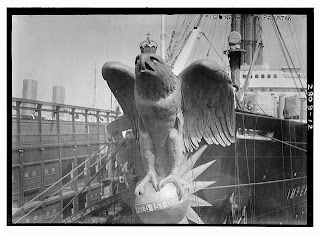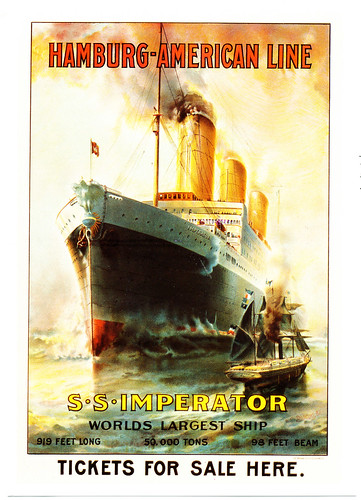Massive liner once carried 12,000 Passengers
 |
| Imperator at anchor 1913 |
 |
| The massive bronze eagle on the bow |
 |
| Postcard of SS Imperator 1913 |
 |
| Cigarette card showing RMS Berengaria post-1920 |
 |
| Picture of the brand new Imperator in 1913 |
By Roderick Eime
Even as the band aboard RMS Titanic struck up their final rendition of “Nearer, My God, to Thee”, the finishing touches of an even larger ocean liner were being added.
At 261m and more than 46,000 GRT, the Titanic and her sisters Olympic and Britannic, were about to be surpassed by the massive German vessel, SS Imperator, which would stretch to 276m and weigh an unheard-of 52,117 gross tons. On her bow a massive bronze eagle figurehead was hurriedly installed to counter the new RMS Aquitania which would otherwise be 12 inches longer.
4,234 passengers could travel aboard her in four classes, with some 900 in first class alone. Among her luxury appointments were a twin-deck swimming pool and Ritz-Carlton Restaurant, complete with orchestra. Her four massive propellers ran smoothly and silently at a distance from the hull – a problem recognised in earlier designs that created worrying vibrations.
Her maiden voyage took place on 10 June 1913 and to much fanfare, she sailed out of Hamburg. Despite the press acclaim and much chest-beating by her owners, the Hamburg America Line (HAPAG), there was trouble with the ship. She sailed uncomfortably in heavy seas, swaying awkwardly from side to side and it turned out she was top heavy. The unkind nickname of “Limperator” was soon applied.
In October she was back in the new AG Vulcan Hamburg shipyard for urgent remedial work which included stripping out the marble bathrooms, shaving three metres off the four funnels and replacing heavy furniture with wicker. The most radical action was pouring 2000 tons of concrete between the double hull.
When she returned to service in March 1914, the route ahead looked promising, but came to an abrupt halt with the declaration of war. HAPAG Director, Albert Ballin, had campaigned doggedly to avoid war, but events escalated during Imperator‘s July eastward crossing. She made full steam for Hamburg and sat out the conflict under crude camouflage.
After the signing of the Armistice in November 1918, Germany was stripped of assets and territories, with the Imperator renamed USS Leviathan and going into service as a much-needed troopship. On one journey she carried 12,000 passengers.
By August of 1919, her military duty was complete and she reverted to Britain, being renamed again. From now until the end of her days, she would sail as RMS Berengaria with Cunard and White-Star. There was more urgent work carried out in Liverpool and she did not return to service until July 1920, where Sir Arthur Rostron, the heroic former captain of the Carpathia, was assigned command. The German-built vessel served as Cunard flagship until 1934 when, in a further twist of irony, she was replaced by another larger (291m) ex-German vessel, the former SS Bismarck.
Her final days were not bathed in glory and like other once magnificent liners, she suffered the ignominy of cut-price, prohibition-dodging cruises where she earned the new nickname “Bargain-Area”. In the end, her aging wiring was prone to catch fire and her owners retired her in 1938. By 1946, her scrapping was complete.
For more detail on SS Imperator, see www.freewebs.com/ultimateimperator



1 Responses to Massive liner once carried 12,000 Passengers
You must be logged in to post a comment Login